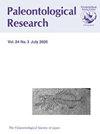A New Fossil Rorqual Aff. Balaenoptera Bertae Specimen from the Shinazawa Formation (Late Pliocene to Early Pleistocene), Yamagata, Japan
IF 0.6
4区 地球科学
Q3 PALEONTOLOGY
引用次数: 0
Abstract
Abstract. More than 23 extinct species and 10 extant species of the Balaenopteridae are known. Our knowledge of the family Balaenopteridae is increasing quickly, however, few fossil records support a circum-North Pacific distribution of balaenopterid genera and species. Because of limited preservations, most rorqual fossils reported from the western North Pacific can only be identified to the family level. A skull from the Shinazawa Formation (late Pliocene to Early Pleistocene) in Yamagata, Japan, is identified as aff. Balaenoptera bertae by possessing two diagnostic features of the species: large occipital condyles, and a posteriorly elongate postglenoid process. Combination of four more features also support that the specimen is a closely related to B. bertae. The specimen is probably a slightly older individual than the holotype of B. bertae, based on the estimated bizygomatic width and slightly longer posterior process of the tympanoperiotic. The first and only report of B. bertae was from the Pliocene Purisima Formation in California, USA. The specimen from Japan is incompletely preserved, but shows the occurrence of B. bertae in the western North Pacific for the first time, as many living balaenopterids are distributed across the North Pacific, such as Balaenoptera musculus, B. physalus, B. borealis, B. acutorostrata, and Megaptera novaeangliae.一个新的化石Rorqual事件。日本山形县新泽组(上新世晚期至更新世早期)的Balaenoptera Bertae标本
摘要已知有超过23种已灭绝物种和10种现存物种。我们对平衡蝶科的了解正在迅速增加,然而,很少有化石记录支持平衡蝶属和物种在北太平洋的分布。由于保存有限,北太平洋西部报告的大多数rorqual化石只能在家族层面上进行鉴定。日本山形县新泽组(上新世晚期至更新世早期)的一个头骨被鉴定为aff。Balaenoptera bertae具有该物种的两个诊断特征:大的枕髁和向后细长的关节后突。另外四个特征的结合也支持了该标本与B.bertae的亲缘关系密切。根据估计的双颧骨宽度和鼓室周突稍长的后突,该标本可能比B.bertae的正模略老。关于B.bertae的第一份也是唯一一份报告来自美国加利福尼亚州的上新世Purisima组。来自日本的标本保存不完整,但首次显示了B.bertae在北太平洋西部的出现,因为许多现存的平衡蝶分布在北太平洋,如肌肉平衡蝶、physalus,和新翅目。
本文章由计算机程序翻译,如有差异,请以英文原文为准。
求助全文
约1分钟内获得全文
求助全文
来源期刊

Paleontological Research
PALEONTOLOGY-
CiteScore
1.60
自引率
0.00%
发文量
47
审稿时长
>12 weeks
期刊介绍:
Paleonotological Research (PR) is a quarterly, peer-reviewed international journal, which focuses on original contributions primarily in the area of paleontology but also covering a wide range of allied sciences. It has been published since 1997 as a successor to the former journal Transactions and Proceedings of the Palaeontological Society of Japan. The emphasis of contributions will include global and local perspectives, and contents can cover all ages (Precambrian to the Quaternary, including the present time).
 求助内容:
求助内容: 应助结果提醒方式:
应助结果提醒方式:


